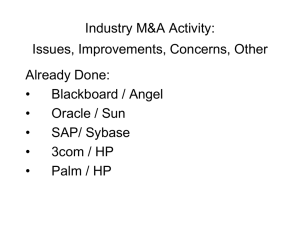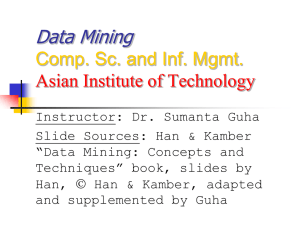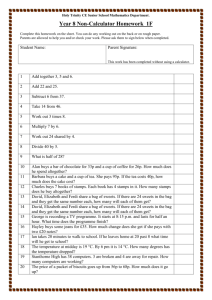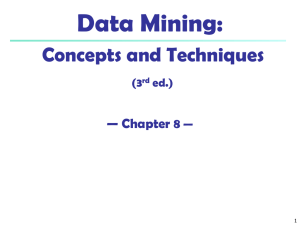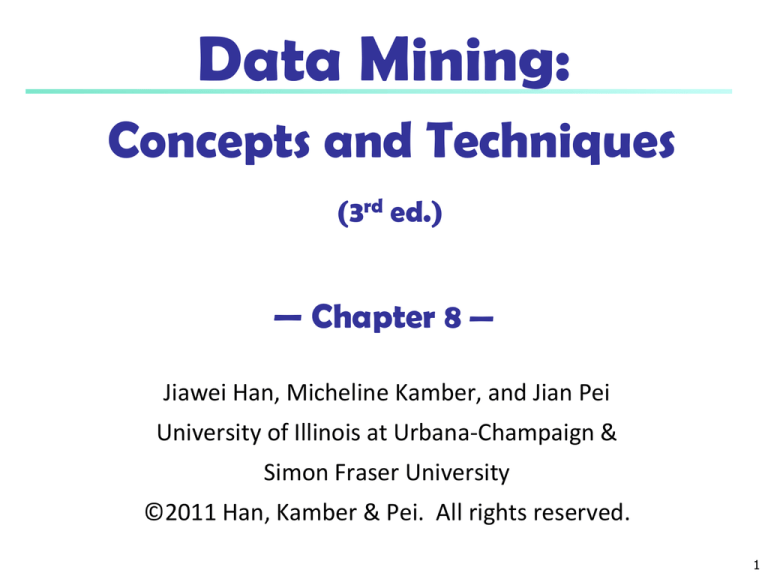
Data Mining:
Concepts and Techniques
(3rd ed.)
— Chapter 8 —
Jiawei Han, Micheline Kamber, and Jian Pei
University of Illinois at Urbana-Champaign &
Simon Fraser University
©2011 Han, Kamber & Pei. All rights reserved.
1
Chapter 8. Classification: Basic Concepts
Classification: Basic Concepts
Decision Tree Induction
Bayes Classification Methods
Rule-Based Classification
Model Evaluation and Selection
Summary
2
Supervised vs. Unsupervised Learning
Classification: A form of data analysis that extracts model
describing important data classes
Supervised learning (classification)
Class label of each training tuple is provided
New data is classified based on the training set
Unsupervised learning (clustering)
The class labels of training data is unknown
Number of classes to be learned may not be known in
advance
3
Prediction Problems: Classification vs.
Numeric Prediction
Classification
predicts categorical class labels (discrete or nominal)
classifies data (constructs a model) based on the training
set and the values (class labels) in a classifying attribute
and uses it in classifying new data
Typical applications
Credit/loan approval:
Medical diagnosis: if a tumor is cancerous or benign
Fraud detection: if a transaction is fraudulent
Web page categorization: which category it is
Numeric Prediction
models continuous-valued functions, i.e., predicts
unknown or missing values.
Example, how much will a given customer spend during a
sale?
4
Classification—A Two-Step Process
Model construction: describing a set of predetermined classes
Each tuple/sample is assumed to belong to a predefined class, as
determined by the class label attribute
The set of tuples used for model construction is training set
The model is represented as classification rules, decision trees, or
mathematical formulae
Model usage: for classifying future or unknown objects
Estimate accuracy of the model
The known label of test sample is compared with the classified
result from the model
Accuracy rate is the percentage of test set samples that are
correctly classified by the model
Test set is independent of training set (otherwise overfitting)
If the accuracy is acceptable, use the model to classify new data
5
Process (1): Model Construction
Training
Data
NAME
M ike
M ary
B ill
Jim
D ave
Anne
RANK
YEARS TENURED
A ssistan t P ro f
3
no
A ssistan t P ro f
7
yes
P ro fesso r
2
yes
A sso ciate P ro f
7
yes
A ssistan t P ro f
6
no
A sso ciate P ro f
3
no
Classification
Algorithms
Classifier
(Model)
IF rank = ‘professor’
OR years > 6
THEN tenured = ‘yes’
6
Process (2): Using the Model in Prediction
Classifier
Testing
Data
Unseen Data
(Jeff, Professor, 4)
NAME
Tom
Merlisa
George
Joseph
RANK
YEARS TENURED
Assistant Prof
2
no
Associate Prof
7
no
Professor
5
yes
Assistant Prof
7
yes
Tenured?
7
Chapter 8. Classification: Basic Concepts
Classification: Basic Concepts
Decision Tree Induction
Bayes Classification Methods
Rule-Based Classification
Model Evaluation and Selection
Summary
8
Decision Tree Induction: An Example
age?
<=30
31..40
overcast
student?
no
no
yes
yes
yes
>40
age
<=30
<=30
31…40
>40
>40
>40
31…40
<=30
<=30
>40
<=30
31…40
31…40
>40
income student credit_rating buys_computer
high
no fair
no
high
no excellent
no
high
no fair
yes
medium
no fair
yes
low
yes fair
yes
low
yes excellent
no
low
yes excellent
yes
medium
no fair
no
low
yes fair
yes
medium yes fair
yes
medium yes excellent
yes
medium
no excellent
yes
high
yes fair
yes
medium
no excellent
no
credit rating?
excellent
fair
yes
9
Algorithm for Decision Tree Induction
Basic algorithm (a greedy algorithm)
Tree is constructed in a top-down recursive divide-andconquer manner
At start, all the training examples are at the root
Attributes are categorical (if continuous-valued, they are
discretized in advance)
Examples are partitioned recursively based on selected
attributes
Test attributes are selected on the basis of a heuristic or
statistical measure (e.g., information gain)
Conditions for stopping partitioning
All samples for a given node belong to the same class
There are no remaining attributes for further partitioning
There are no samples left
10
Attribute Selection Measure:
Information Gain (ID3/C4.5)
Select the attribute with the highest information gain
Let pi be the probability that an arbitrary tuple in D belongs to
class Ci
Expected information (entropy) needed to classify a tuple in D:
m
Info( D) pi log 2 ( pi )
i 1
Information needed (after using A to split D into v partitions) to
v | D |
classify D:
j
InfoA ( D)
Info( D j )
j 1 | D |
Information gained by branching on attribute A
Gain(A) Info(D) InfoA(D)
11
Attribute Selection: Information Gain
Class P: buys_computer = “yes”
Class N: buys_computer = “no”
Info( D) I (9,5)
age
<=30
31…40
>40
age
<=30
<=30
31…40
>40
>40
>40
31…40
<=30
<=30
>40
<=30
31…40
31…40
>40
Infoage ( D )
9
9
5
5
log 2 ( ) log 2 ( ) 0.940
14
14 14
14
pi
2
4
3
ni I(pi, ni)
3 0.971
0 0
2 0.971
income student credit_rating
high
no
fair
high
no
excellent
high
no
fair
medium
no
fair
low
yes fair
low
yes excellent
low
yes excellent
medium
no
fair
low
yes fair
medium
yes fair
medium
yes excellent
medium
no
excellent
high
yes fair
medium
no
excellent
buys_computer
no
no
yes
yes
yes
no
yes
no
yes
yes
yes
yes
yes
no
5
4
I ( 2,3)
I (4,0)
14
14
5
I (3,2) 0.694
14
5
I (2,3)means “age <=30” has 5 out of
14
14 samples, with 2 yes’es and 3
no’s. Hence
Gain(age) Info( D) Infoage ( D) 0.246
Similarly,
Gain(income) 0.029
Gain( student ) 0.151
Gain(credit _ rating ) 0.048
12
Gain Ratio for Attribute Selection (C4.5)
Information gain measure is biased towards attributes with a
large number of values
C4.5 (a successor of ID3) uses gain ratio to overcome the
problem (normalization to information gain)
v
SplitInfo A ( D)
j 1
| Dj |
|D|
log 2 (
| Dj |
|D|
)
GainRatio(A) = Gain(A)/SplitInfo(A)
Ex.
gain_ratio(income) = 0.029/1.557 = 0.019
The attribute with the maximum gain ratio is selected as the
splitting attribute
13
Gini Index (CART, IBM IntelligentMiner)
If a data set D contains examples from n classes, gini index,
n
gini(D) is defined as
2
gini( D) 1 p j
j 1
where pj is the relative frequency of class j in D
If a data set D is split on A into two subsets D1 and D2, the gini
index gini(D) is defined as
gini A (D)
|D1|
|D |
gini(D1) 2 gini(D2)
|D|
|D|
Reduction in Impurity:
The attribute provides the smallest ginisplit(D) (or the largest
reduction in impurity) is chosen to split the node
gini( A) gini(D) giniA(D)
14
Computation of Gini Index
Ex. D has 9 tuples in buys_computer = “yes” and 5 in “no”
2
2
9 5
gini ( D) 1 0.459
14 14
Suppose the attribute income partitions D into 10 in D1: {low, medium} and 4
10
4
in D2
gini
( D) Gini ( D ) Gini ( D )
income{low, medium}
14
1
14
2
Similarly, Gini{low,high} is 0.458 and Gini{medium,high} is 0.450.
Evaluating age, we obtain {youth, senior} or {middle-aged} as the best split
with Gini index of 0.357
The attributes student and credit_rating are both binary with Gini index values
of 0.367 and 0.429.
Therefore, the attribute age and splitting subset {youth, senior} gives the
minimum Gini index overall and is used as the splitting criterion.
15
Comparing Attribute Selection Measures
The three measures, in general, return good results but
Information gain:
Gain ratio:
biased towards multivalued attributes
tends to prefer unbalanced splits in which one partition is
much smaller than the others
Gini index:
biased to multivalued attributes
has difficulty when # of classes is large
16
Overfitting and Tree Pruning
Overfitting: An induced tree may overfit the training data
Too many branches, some may reflect anomalies due to
noise or outliers
Poor accuracy for unseen samples
Two approaches to avoid overfitting
Prepruning: Halt tree construction early ̵ do not split a node
if this would result in the goodness measure falling below a
threshold
Difficult to choose an appropriate threshold
Postpruning: Remove branches from a “fully grown” tree—
get a sequence of progressively pruned trees
Use a set of data different from the training data to
decide which is the “best pruned tree”
17
Overfitting and Tree Pruning
An unpruned decision tree and a pruned version of it
18
Chapter 8. Classification: Basic Concepts
Classification: Basic Concepts
Decision Tree Induction
Bayes Classification Methods
Rule-Based Classification
Model Evaluation and Selection
Summary
19
Bayesian Classification: Why?
A statistical classifier: predict class membership probabilities
such as the probability that a given tuple belongs to a
particular class
Foundation: Based on Bayes’ Theorem.
Performance: A simple Bayesian classifier, naïve Bayesian
classifier, has comparable performance with decision tree and
selected neural network classifiers
20
Bayes’ Theorem: Basics
Bayes’ Theorem:
P(H | X) P(X | H )P(H ) P(X | H ) P(H ) / P(X)
P(X)
Let X be a data sample (“evidence”): class label is unknown
Let H be a hypothesis that X belongs to class C
Classification is to determine P(H|X), (i.e., posteriori probability): the
probability that the hypothesis holds given the observed data sample X
P(H) (prior probability): the initial probability
P(X): probability that sample data is observed
P(X|H) (likelihood): the probability of observing the sample X, given that
the hypothesis holds
E.g., Given that X will buy computer, the prob. that X is 31..40,
medium income
21
Bayes’ Theorem: Example
Assume that you are presented with three coins, two of them fair and the
other a counterfeit that always lands heads. If you randomly pick one of the
three coins, the probability that it's the counterfeit is 1 in 3. This is the prior
probability of the hypothesis that the coin is counterfeit. Now after picking
the coin, you flip it three times and observe that it lands heads each time.
Seeing this new evidence that your chosen coin has landed heads three times
in a row, you want to know the revised posterior probability that it is the
counterfeit. The answer to this question, found using Bayes's theorem is 4 in
5. You thus revise your probability estimate of the coin's being counterfeit
upward from 1 in 3 to 4 in 5."
22
Bayes’ Theorem: Example
23
Classification Is to Derive the Maximum Posteriori
Let D be a training set of tuples and their associated class
labels, and each tuple is represented by an n-D attribute vector
X = (x1, x2, …, xn)
Suppose there are m classes C1, C2, …, Cm.
Classification is to derive the maximum posteriori, i.e., the
maximal P(Ci|X)
This can be derived from Bayes’ theorem
P(X | C )P(C )
i
i
P(C | X)
i
P(X)
Since P(X) is constant for all classes, only
P(C | X) P(X | C )P(C )
i
i
i
needs to be maximized
24
Naïve Bayes Classifier
A simplified assumption: attributes are conditionally
independent (i.e., no dependence relation between
attributes):
This greatly reduces the computation cost: Only counts the
class distribution
n
P( X | C i) P( x | C i) P( x | C i ) P( x | C i) ... P( x | C i)
k
1
2
n
k 1
25
Naïve Bayes Classifier: Training Dataset
Class:
C1:buys_computer = ‘yes’
C2:buys_computer = ‘no’
Data to be classified:
X = (age <=30,
Income = medium,
Student = yes
Credit_rating = Fair)
age
<=30
<=30
31…40
>40
>40
>40
31…40
<=30
<=30
>40
<=30
31…40
31…40
>40
income studentcredit_rating
buys_compu
high
no fair
no
high
no excellent
no
high
no fair
yes
medium no fair
yes
low
yes fair
yes
low
yes excellent
no
low
yes excellent yes
medium no fair
no
low
yes fair
yes
medium yes fair
yes
medium yes excellent yes
medium no excellent yes
high
yes fair
yes
medium no excellent
no
26
Naïve Bayes Classifier: An Example
age
<=30
<=30
31…40
>40
>40
>40
31…40
<=30
<=30
>40
<=30
31…40
31…40
>40
income studentcredit_rating
buys_comp
high
no fair
no
high
no excellent
no
high
no fair
yes
medium
no fair
yes
low
yes fair
yes
low
yes excellent
no
low
yes excellent
yes
medium
no fair
no
low
yes fair
yes
medium yes fair
yes
medium yes excellent
yes
medium
no excellent
yes
high
yes fair
yes
medium
no excellent
no
P(Ci): P(buys_computer = “yes”) = 9/14 = 0.643
P(buys_computer = “no”) = 5/14= 0.357
Compute P(X|Ci) for each class
P(age = “<=30” | buys_computer = “yes”) = 2/9 = 0.222
P(age = “<= 30” | buys_computer = “no”) = 3/5 = 0.6
P(income = “medium” | buys_computer = “yes”) = 4/9 = 0.444
P(income = “medium” | buys_computer = “no”) = 2/5 = 0.4
P(student = “yes” | buys_computer = “yes) = 6/9 = 0.667
P(student = “yes” | buys_computer = “no”) = 1/5 = 0.2
P(credit_rating = “fair” | buys_computer = “yes”) = 6/9 = 0.667
P(credit_rating = “fair” | buys_computer = “no”) = 2/5 = 0.4
X = (age <= 30 , income = medium, student = yes, credit_rating = fair)
P(X|Ci) : P(X|buys_computer = “yes”) = 0.222 x 0.444 x 0.667 x 0.667 = 0.044
P(X|buys_computer = “no”) = 0.6 x 0.4 x 0.2 x 0.4 = 0.019
P(X|Ci)*P(Ci) : P(X|buys_computer = “yes”) * P(buys_computer = “yes”) = 0.028
P(X|buys_computer = “no”) * P(buys_computer = “no”) = 0.007
Therefore, X belongs to class (“buys_computer = yes”)
27
Avoiding the Zero-Probability Problem
Naïve Bayesian prediction requires each conditional prob. be
non-zero. Otherwise, the predicted prob. will be zero
P( X | C i)
n
P( x k | C i)
k 1
Ex. Suppose a dataset with 1000 tuples, income=low (0),
income= medium (990), and income = high (10)
Use Laplacian correction (or Laplacian estimator)
Adding 1 to each case
Prob(income = low) = 1/1003
Prob(income = medium) = 991/1003
Prob(income = high) = 11/1003
The “corrected” prob. estimates are close to their
“uncorrected” counterparts
28
Naïve Bayes Classifier: Comments
Advantages
Easy to implement
Good results obtained in most of the cases
Disadvantages
Assumption: class conditional independence, therefore loss
of accuracy
Practically, dependencies exist among variables
Dependencies among these cannot be modeled by Naïve
Bayes Classifier
How to deal with these dependencies? Bayesian Belief Networks
29
Chapter 8. Classification: Basic Concepts
Classification: Basic Concepts
Decision Tree Induction
Bayes Classification Methods
Rule-Based Classification
Model Evaluation and Selection
Summary
30
Using IF-THEN Rules for Classification
Represent the knowledge in the form of IF-THEN rules
R: IF age = youth AND student = yes THEN buys_computer = yes
Rule antecedent/precondition vs. rule consequent
Assessment of a rule: coverage and accuracy
ncovers = # of tuples covered by R
ncorrect = # of tuples correctly classified by R
coverage(R) = ncovers /|D| /* D: training data set */
accuracy(R) = ncorrect / ncovers
If more than one rule are triggered, need conflict resolution
Size ordering: assign the highest priority to the triggering rules that has the
“toughest” requirement (i.e., with the most attribute tests)
Class-based ordering: classes are sorted in decreasing order of importance,
rule that predicts the most important class gets the priority
Rule-based ordering (decision list): rules are organized into one long priority
list, according to some measure of rule quality such by accuracy, coverage or
by experts advice
31
Rule Extraction from a Decision Tree
Rules are easier to understand than large
trees
age?
One rule is created for each path from the
<=30
31..40
root to a leaf
student?
yes
Each attribute-value pair along a path forms a
no
yes
conjunction: the leaf holds the class
no
yes
prediction
Rules are mutually exclusive and exhaustive
Example: Rule extraction from our buys_computer decision-tree
>40
credit rating?
excellent
IF age = young AND student = no
THEN buys_computer = no
IF age = young AND student = yes
THEN buys_computer = yes
IF age = mid-age
THEN buys_computer = yes
IF age = old AND credit_rating = excellent THEN buys_computer = no
IF age = old AND credit_rating = fair
THEN buys_computer = yes
fair
yes
32
Rule Induction: Sequential Covering Method
Sequential covering algorithm: Extracts rules directly from training
data
Typical sequential covering algorithms: FOIL, AQ, CN2, RIPPER
Rules are learned sequentially, each for a given class Ci will cover
many tuples of Ci but none (or few) of the tuples of other classes
Steps:
Rules are learned one at a time
Each time a rule is learned, the tuples covered by the rules are
removed
Repeat the process on the remaining tuples until termination
condition, e.g., when no more training examples or when the
quality of a rule returned is below a user-specified threshold
33
Chapter 8. Classification: Basic Concepts
Classification: Basic Concepts
Decision Tree Induction
Bayes Classification Methods
Rule-Based Classification
Model Evaluation and Selection
Summary
34
Classifier Evaluation Metrics: Confusion
Matrix
Confusion Matrix:
Actual class\Predicted class
C1
¬ C1
C1
True Positives (TP)
False Negatives (FN)
¬ C1
False Positives (FP)
True Negatives (TN)
Example of Confusion Matrix:
Actual class\Predicted buy_computer buy_computer
class
= yes
= no
Total
buy_computer = yes
6954
46
7000
buy_computer = no
412
2588
3000
Total
7366
2634
10000
Given m classes, an entry, CMi,j in a confusion matrix indicates
# of tuples in class i that were labeled by the classifier as class j
May have extra rows/columns to provide totals
35
Classifier Evaluation Metrics: Accuracy,
Error Rate, Sensitivity and Specificity
A\P
C
C
TP FN
P
¬C
FP TN
N
P’
¬C
N’ All
Classifier Accuracy, or
recognition rate: percentage of
test set tuples that are correctly
classified
Accuracy = (TP + TN)/All
Error rate: 1 – accuracy, or
Error rate = (FP + FN)/All
Sensitivity: True Positive
recognition rate
Sensitivity = TP/P
Specificity: True Negative
recognition rate
Specificity = TN/N
36
Classifier Evaluation Metrics:
Precision and Recall, and F-measures
Precision: exactness – what % of tuples that the classifier
labeled as positive are actually positive
Recall: completeness – what % of positive tuples did the
classifier label as positive?
F measure (F1 or F-score): harmonic mean of precision and
recall,
Fß: weighted measure of precision and recall
37
Classifier Evaluation Metrics: Example
Actual Class\Predicted class
cancer = yes
cancer = no
Total
Recognition(%)
cancer = yes
90
210
300
30.00 (sensitivity
cancer = no
140
9560
9700
98.56 (specificity)
Total
230
9770
10000
96.40 (accuracy)
Precision = 90/230 = 39.13%
Recall = 90/300 = 30.00%
38
Chapter 8. Classification: Basic Concepts
Classification: Basic Concepts
Decision Tree Induction
Bayes Classification Methods
Rule-Based Classification
Model Evaluation and Selection
Summary
39
Summary
Classification is a form of data analysis that extracts models
describing important data classes.
Effective and scalable methods have been developed for decision
tree induction, Naive Bayesian classification, rule-based
classification, and many other classification methods.
Evaluation metrics include: accuracy, sensitivity, specificity,
precision, recall, F measure, and Fß measure.
40



